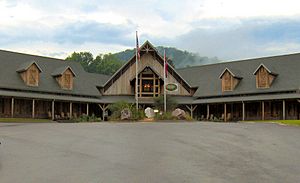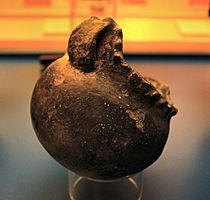Great Smoky Mountains Heritage Center facts for kids
 |
|
| Established | 2006 |
|---|---|
| Location | 123 Cromwell Drive, Townsend, Tennessee, United States |
The Great Smoky Mountains Heritage Center is a special museum in Townsend, Tennessee. It's located right near the entrance to the famous Great Smoky Mountains National Park. The museum's goal is to share the history and culture of the people who have lived in the Great Smoky Mountains. This includes the region's first people, the Native Americans, and the settlers who later made their homes in the Appalachian mountains.
The museum opened in 2006 and has both indoor and outdoor areas for visitors to explore. Outside, you can walk through real historic buildings from the area. These include a log cabin, two special barns called cantilever barns, a church, a sawmill, and a house from an old logging town. Inside, you can see tools, furniture, and musical instruments that mountain families used long ago. There is also a large collection of Cherokee artifacts, some of which are thousands of years old.
Contents
How the Center Began
The idea for the Great Smoky Mountains Heritage Center came from a local history lover named Richard Way in the early 2000s. Many people and groups in the Townsend area worked together to raise money and make the museum a reality. They broke ground in the summer of 2004, and the center officially opened its doors on February 12, 2006.
When it first opened, the center showed off Cherokee artifacts and tools used by early mountain settlers. One popular exhibit was called "Tennessee on the Move." It had a small car with a video screen that let visitors feel what it was like to drive on a mountain road back in 1925.
Over the years, the center has added more amazing pieces of history. In 2008, it received a historic still, which is equipment used to make strong homemade drinks. In 2010, a 100-year-old church building was moved to the center from the nearby town of Maryville. The museum has been very successful, welcoming over 75,000 visitors in its first three years.
What You Can See Inside and Out

The Heritage Center has two main indoor galleries. One gallery is all about the region's Native American history. The other focuses on the lives of the pioneers and mountain families who settled here later. There is also a transportation gallery that shows how people got around, from horse-drawn wagons to cars.
Outdoor Exhibits
The outdoor area is like a village from the past. You can explore nearly a dozen historic buildings that were moved here from all over the region.
- The Cardwell Cabin is a log cabin built in the 1890s.
- The Wilders Chapel was a church for an African American community, built in 1910.
- Two cantilever barns show a unique style of barn that was common in East Tennessee.
- A smokehouse and a granary show how families preserved meat and stored grain.
- A "setoff" house is a type of small home that people in logging towns lived in.
- The Williams still is an example of equipment used to make illegal spirits, known as moonshine, in the mountains.
Indoor Galleries
The main gallery is split into two parts. The Native American section has artifacts from different time periods, going back thousands of years. Many of these items were found during an archaeological dig in Townsend between 1999 and 2001.
The pioneer gallery shows what life was like in the late 1800s and early 1900s. You can see a bedroom set up just like it would have been, along with tools for farming and a banjo that was once played by someone living in Cades Cove.
The center also has a special gallery for temporary exhibits. In the past, it has shown collections of old toys, items from a historic department store, and displays about important people who helped create the Great Smoky Mountains National Park.
Historic Buildings at the Center
Here is a list of some of the historic buildings you can see at the Heritage Center.
| Structure | Image | Constructed | Original location |
Builder/principal owner |
|---|---|---|---|---|
| Cardwell Cabin |  |
1892–1895 | Sevier County, Tennessee | James Andrew Cardwell |
| Outhouse | ||||
| Smokehouse |  |
|||
| Cantilever barn | ||||
| Williams moonshine still |  |
1960 | Townsend, Tennessee | Charlie Williams |
| Wilders Chapel A.M.E Zion Church |  |
1910 | Maryville, Tennessee | |
| Montvale Station | Montvale Springs, Tennessee | |||
| Long granary |  |
1890s | Loudon County, Tennessee | Isaac Long |
| Long cantilever barn |  |
1886 (appx.) | Loudon County, Tennessee | Isaac Long |
| Wheelwright shop | ||||
| Sawmill |  |
1885 (appx.) | ||
| Setoff house |  |
See also

